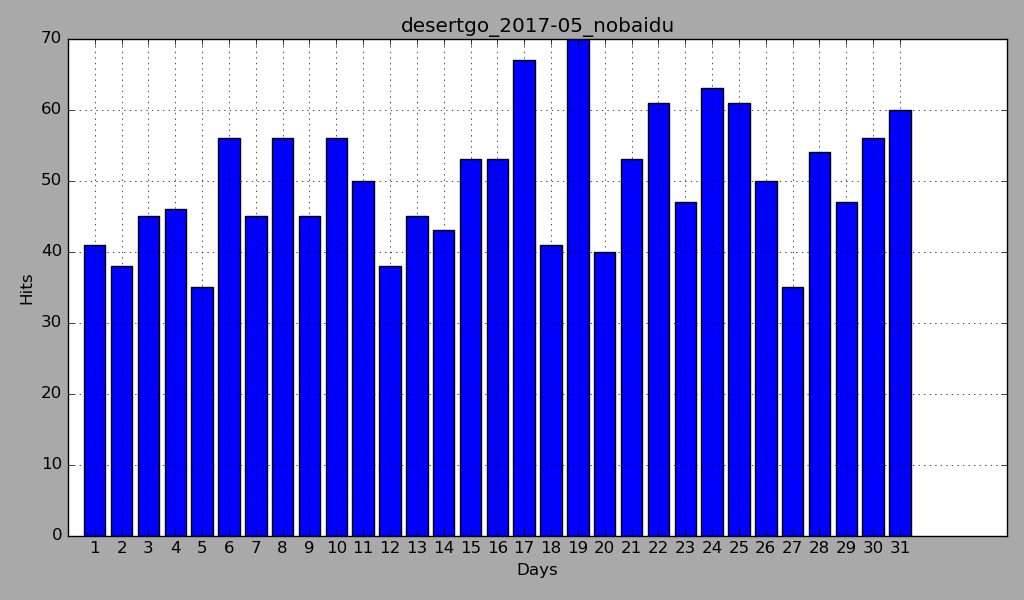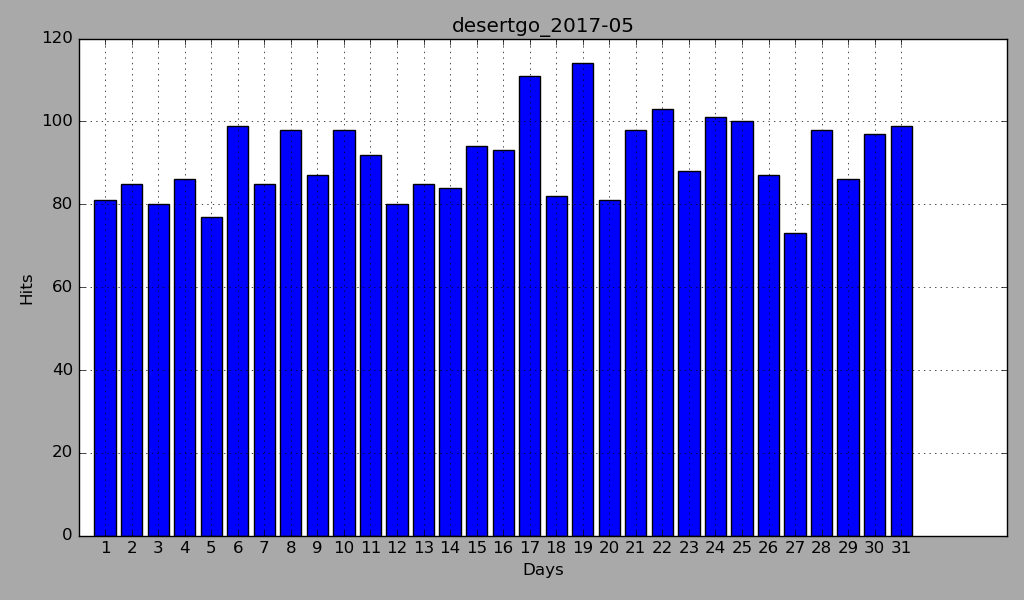Home · Projects · 2017 · Custom Traffic Parser and Plotter



I wanted a simple way to output some bar graphs showing how many hits each of my sites was getting every month. Even though there are tons of off the shelf solutions, I, of course, had to roll my own. I started by writing Parser.py , which reads the apache logs for a given site/month and outputs a JSON file. This JSON file has a “header” that lists the total and unique hits for that month, followed by a normal JSON formatted daily listing of every unique IP. This is scheduled to run the first of every month via cron. These files are much smaller than the corresponding apache files, but of course do not contain nearly as much information.

Next, I wrote Plotter.py to read these JSON files and output the aforementioned bar graph via matplotlib. I added an option, –nobaidu, to strip out all of the traffic coming from 180.76.15.xxx. Baidu’s spider is relentless, weighing in at ~40 crawls per day. This is easily extendible to any given domain. You could even add an option that takes the IP range to exclude from the CLI.


#!/usr/bin/env python
#Author: Mark Feineigle
#Create Date: 2017/06/23
import argparse
from collections import defaultdict, OrderedDict
from commands import getoutput
from datetime import datetime as dt
import json
import os
import sys
parser = argparse.ArgumentParser()
parser.add_argument("site", help="""site to parse = conected,
desertgo,
feineigle""")
parser.add_argument("-y", "--year", default=str(dt.now().year),
help="""Year to parse.
Default is this year.""")
parser.add_argument("-m", "--month", default=str(dt.now().month-1),
help="""Month to parse (1-12).
Default is LAST month.""")
parser.add_argument("-a", "--all", action="store_true",
help="Parse all months.")
args = parser.parse_args()
# scans the whole shebang of logs for a given site
def extract_all_logs(logPath):
ips = []
for filename in os.listdir(logPath):
if filename.startswith("access"):
if "gz" not in filename:
ips.append(getoutput("cat "+logPath+filename+" | awk {'print $1 $4'}"))
else:
ips.append(getoutput("gunzip -c "+logPath+filename+" | awk {'print $1 $4'}"))
# reformat the logs into a list:
# ['2017-04-25 - 100.43.90.9', '2017-04-25 - 100.43.90.9', ...]
ips = "\n".join(ips)
ips = ips.split("\n")
ips = [ip.split("[") for ip in ips if len(ip) > 1]
ips = [dt.strftime(dt.strptime(date,"%d/%b/%Y:%H:%M:%S"),"%Y-%m-%d")+" - "+ip
for ip, date in ips]
return ips
def extract_month_from(month, ips):
# sort out the month in question
dd = defaultdict(set)
tot_mo_hits = 0
for line in ips:
if line.startswith(year+"-"+month):
tot_mo_hits += 1
date , ip = line.strip().split(" - ")
dd[date].add(ip)
# order the month by day
od = OrderedDict()
for key, val in sorted(dd.items()):
od[key] = list(val)
data = json.dumps(od, indent=2)
tot_mo_unique = sum([len(day) for day in od.values()])
return (data, tot_mo_hits, tot_mo_unique)
def write_month_log(outPath, data, tot_mo_hits, tot_mo_unique):
with open(outPath, "w") as fi:
fi.write("Total hits: "+str(tot_mo_hits)+"\n")
fi.write("Total unique hits: "+str(tot_mo_unique)+"\n")
fi.write(data)
if __name__ == "__main__":
site = args.site #desertgo, feineigle, conected
year = args.year
months = [args.month.zfill(2)] #pad with zeros if needed
logPath = "/var/log/apache2/"+site+"/"
archivePath = "/var/log/apache2/archive/"+site
if not os.path.isdir(archivePath):
os.mkdir(archivePath)
# Loop for extraqcting all months at once (-a argument)
if args.all == True:
months = [str(m).zfill(2) for m in range(1,13)]
for month in months:
outPath = os.path.join(archivePath, site+"_"+year+"-"+month+".txt")
ips = extract_all_logs(logPath)
data, tot_mo_hits, tot_mo_unique = extract_month_from(month, ips)
if len(data) > 2:
write_month_log(outPath, data, tot_mo_hits, tot_mo_unique)
Source: Parser.py
#!/usr/bin/env python
#Author: Mark Feineigle
#Create Date: 2017/06/24
import argparse
from datetime import datetime as dt
import json
import matplotlib.pyplot as plt
import os
import sys
parser = argparse.ArgumentParser()
parser.add_argument("site", help="""site to parse = conected,
desertgo,
feineigle""")
parser.add_argument("-y", "--year", default=str(dt.now().year),
help="""Year to parse.
Default is this year.""")
parser.add_argument("-m", "--month", default=str(dt.now().month-1),
help="""Month to parse (1-12).
Default is LAST month.""")
parser.add_argument("-a", "--all", action="store_true",
help="Parse all months.")
parser.add_argument("--nobaidu", action="store_true",
help="Don't plot baidu spider hits.")
args = parser.parse_args()
def read_json_log(logPath):
with open(logPath, "r") as fi:
data = fi.read()
data = data[data.find("{"):] #cut off the first 2 lines/header (hits)
data = json.loads(data)
return data
def parse_json(data):
xs, ys = [], []
for key, val in sorted(data.items()):
xs.append(float(key[-2:])) #key/xs = days
if args.nobaidu == True:
val = [v for v in val if not v.startswith("180.76.15.")]
ys.append(float(len(val))) #val/ys = hits
return (xs, ys)
def construct_plot(xs, ys, site, filename):
if args.nobaidu == True:
filename = filename+"_nobaidu"
plt.figure(figsize=(10.24,6))
plt.bar(xs, ys, align="center")
plt.xticks(xs)
plt.title(filename)
plt.xlabel("Days")
plt.ylabel("Hits")
plt.grid(True)
plt.tight_layout(1)
plt.rcParams["savefig.facecolor"] = "darkgrey"
#plt.show() #NOTE remove after tests
if not os.path.exists(os.path.join(site, "img")):
os.mkdir(os.path.join(site, "img"))
plt.savefig(os.path.join(site, "img", filename+".png"))
plt.clf() #clear in case of loop
def process_log(logPath, site, filename):
try:
data = read_json_log(logPath)
except IOError as e:
return
xs, ys = parse_json(data)
if len(xs) == 0: #there is no data
return
print "Processing {}\r".format(filename),
sys.stdout.flush()
construct_plot(xs, ys, site, filename)
if __name__ == "__main__":
site = args.site
year = args.year
months = [args.month.zfill(2)]
if args.all == True:
months = [str(m).zfill(2) for m in range(1,13)]
for month in months:
filename = site+"_"+year+"-"+month
logPath = site+"/"+filename+".txt"
process_log(logPath, site, filename)
print ""
Source: Plotter.py